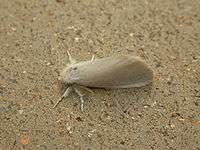Acyphas semiochrea
Acyphas semiochrea, the omnivorous tussock moth, is a moth of the subfamily Lymantriinae first described by Gottlieb August Wilhelm Herrich-Schäffer in 1855. It is found along most of the coast of Australia, including: New South Wales, Queensland, South Australia, Tasmania, Victoria and Western Australia.[1]


| Acyphas semiochrea | |
|---|---|
 | |
| Scientific classification | |
| Kingdom: | |
| Phylum: | |
| Class: | |
| Order: | |
| Family: | |
| Genus: | |
| Species: | A. semiochrea |
| Binomial name | |
| Acyphas semiochrea (Herrich-Schäffer, 1855) | |
| Synonyms | |
| |
The wingspan is about 30 mm. Adult females are white and have an orange tuft on the tail. Males are also white but sometimes have a dark mark at the tornus of each forewing or a broad dark band along the margin of each forewing. The hairs around the thorax are sometimes yellowish. Sometimes the black skin of the thorax and/or abdomen shows through between the white hairs.
It is considered a pest on Pinus radiata, but has also been recorded feeding on Acacia, Eucalyptus, Pultenaea, Dodonaea, Choretrum, Myoporum and Tamarix. The caterpillars are brown and hairy, with a pencil of black hairs each side of its head and a hairy tail.
References
- Herbison-Evans, Don & Crossley, Stella (15 November 2019). "Acyphas semiochrea (Herrich-Schaffer, [1855]) Omnivorous Tussock Moth". Australian Caterpillars and their Butterflies and Moths. Retrieved 14 May 2020.
- "Species Acyphas semiochrea (Herrich-Schäffer, 1855)". Australian Faunal Directory. Archived 5 April 2011.
| Wikispecies has information related to Acyphas semiochrea |
| Wikimedia Commons has media related to Acyphas semiochrea. |